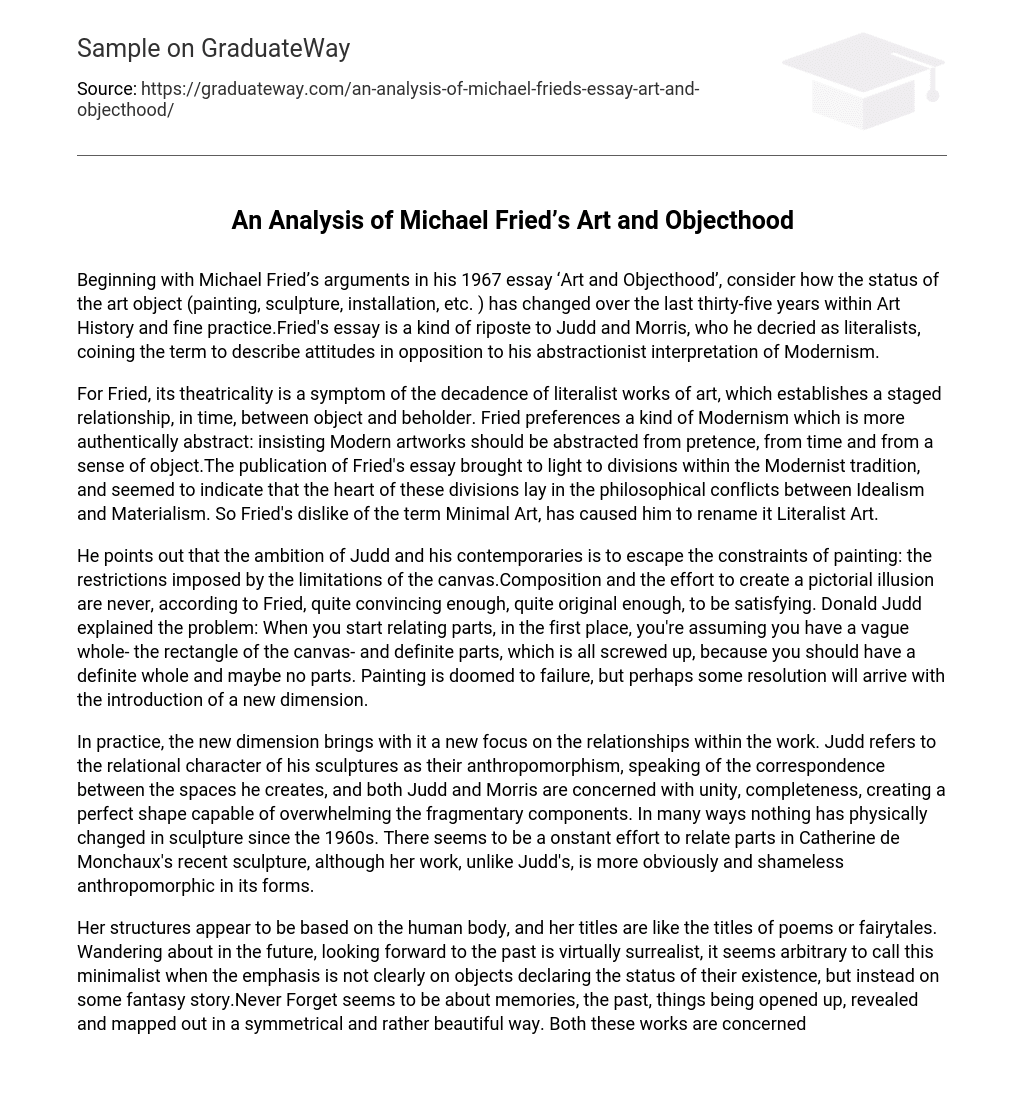Beginning with Michael Fried’s arguments in his 1967 essay ‘Art and Objecthood’, consider how the status of the art object (painting, sculpture, installation, etc. ) has changed over the last thirty-five years within Art History and fine practice.Fried’s essay is a kind of riposte to Judd and Morris, who he decried as literalists, coining the term to describe attitudes in opposition to his abstractionist interpretation of Modernism.
For Fried, its theatricality is a symptom of the decadence of literalist works of art, which establishes a staged relationship, in time, between object and beholder. Fried preferences a kind of Modernism which is more authentically abstract: insisting Modern artworks should be abstracted from pretence, from time and from a sense of object.The publication of Fried’s essay brought to light to divisions within the Modernist tradition, and seemed to indicate that the heart of these divisions lay in the philosophical conflicts between Idealism and Materialism. So Fried’s dislike of the term Minimal Art, has caused him to rename it Literalist Art.
He points out that the ambition of Judd and his contemporaries is to escape the constraints of painting: the restrictions imposed by the limitations of the canvas.Composition and the effort to create a pictorial illusion are never, according to Fried, quite convincing enough, quite original enough, to be satisfying. Donald Judd explained the problem: When you start relating parts, in the first place, you’re assuming you have a vague whole- the rectangle of the canvas- and definite parts, which is all screwed up, because you should have a definite whole and maybe no parts. Painting is doomed to failure, but perhaps some resolution will arrive with the introduction of a new dimension.
In practice, the new dimension brings with it a new focus on the relationships within the work. Judd refers to the relational character of his sculptures as their anthropomorphism, speaking of the correspondence between the spaces he creates, and both Judd and Morris are concerned with unity, completeness, creating a perfect shape capable of overwhelming the fragmentary components. In many ways nothing has physically changed in sculpture since the 1960s. There seems to be a onstant effort to relate parts in Catherine de Monchaux’s recent sculpture, although her work, unlike Judd’s, is more obviously and shameless anthropomorphic in its forms.
Her structures appear to be based on the human body, and her titles are like the titles of poems or fairytales. Wandering about in the future, looking forward to the past is virtually surrealist, it seems arbitrary to call this minimalist when the emphasis is not clearly on objects declaring the status of their existence, but instead on some fantasy story.Never Forget seems to be about memories, the past, things being opened up, revealed and mapped out in a symmetrical and rather beautiful way. Both these works are concerned with the impossible project of re-membering, putting things back together from their parts- and the contrast with Judd is clear- to the extent that they are about parts being reassembled into an ideal whole, de Monchaux’s sculptures are more like paintings.
In many ways, her work resembles Carl Andre’s- particularly his Venus Forge.The viewer’s experience of the work will obviously depend on whether the work is perceived as an object or a subject. In Fried’s conception, the art object becomes animated and serves the holistic aspiration of the artist. But the art work’s subjectivity does not elevate the artist- they have created an object capable of representing itself, and, like Frankenstein observing his monster, are themselves both the observers and observed.
If Hesse is, as her diaries suggest, a woman observing herself, then she has an immediate affinity with Judd.Both artists are engaged in a project of self-replication, where sculpture is an extension of themselves- something projected into space, imbued with some kind of life, in the words of Chav and Fried, written into existence. Fried’s idea can be read as gender-neutral, but the phallocentric commentaries of feminist writers such as Camille Paglia will always present a serious threat to any art theory that preferences the projection and prominence of sculpture over the restrictive bittiness of painting on canvas.For Paglia and her school, sculpture is mostly by and about men, and it is an alarming, violent world of construction, projection, erection and self-aggrandising expressiveness.
Much of this might just as well read as a preliminary sculptural theory: The sexes are caught in a comedy of historical indebtedness. Man, repelled by his debt to a physical mother, created an alternate reality, a heterocosm to give him the illusion of freedom. Woman inflamed with desire for her own llusory freedom, invades man’s systems and suppresses her indebtedness to him as she steals them. Hesse’s feminist works can be read with a melancholic tone of a woman conscious of and raging about a sexual debt but they do not have to be.
Paglia finds male and female equality in Eastern religious traditions: cultures built around ongoing horizontal natural rhythms, unlike the western male preoccupation with vertical climax. Hesse’s interest in the body is, in Paglia’s terms. chthonic- she claimed she wanted to keep her work in the ugly zone, her work defined by





